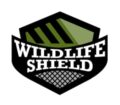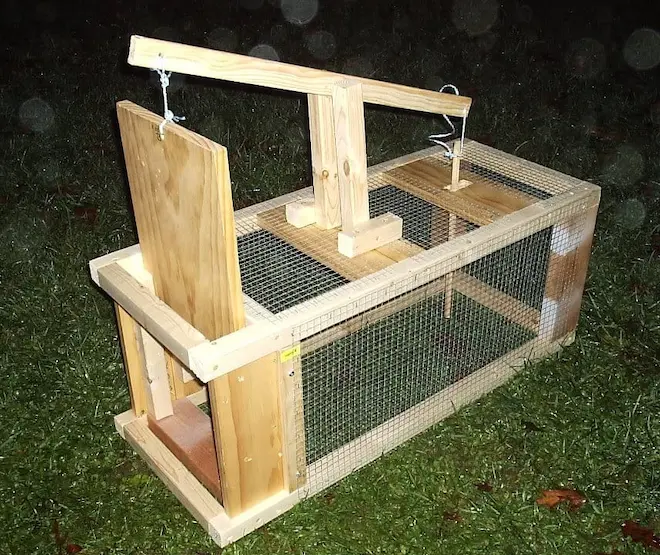Making homemade raccoon traps is fairly easy; all you need is a sturdy wooden plank and a tall barrel or trash can. Use a barrel with a smooth interior so the animal cant grip once trapped inside. However, relocating and releasing raccoons can be a very dangerous process. The raccoon can attack you or can die during the relocation process. Remember that it is illegal to kill wild animals like raccoons in Ontario. Call our raccoon removal Toronto solutions for quick and professional wildlife removal services.
Place the barrel upright next to a picnic table or a flat surface taller than the opening of the barrel. Pour water into the barrel until it’s about 1/3 full but use your discretion. The idea is not to drown the coon but rather to get it wet. The water will make its fur wet and heavy and its claws slippery so it can’t climb out of the barrel.
Next, place a 2-by-4 halfway on the table or flat surface and halfway over the barrel. Ensure that one edge of the board is hanging exactly in the middle of the barrel opening. Place bait such as marshmallows or peanut butter on the edge of the plank hanging over the barrel. Do not use meat bait to avoid attracting neighbourhood pets.
The raccoon should walk across the plank to reach the bait and tip over the wood and into the barrel. Again, make sure that the water is just enough to make the coon wet and not to drown it. Check the trap regularly until you have caught the animal.
How to make a homemade raccoon trap
If you discover raccoons on your property, you may decide to trap the animals with the intention of relocating them elsewhere. But you should know that, in Ontario, all wildlife, including raccoons, is protected by law. Killing raccoons, causing them to suffer, or transporting them for more than one kilometre is illegal.
So, your best course of action if you have nuisance raccoons on your property is to hire a professional wildlife disposal contractor to solve the problem for you.
However, if you do decide to trap a troublesome raccoon, here’s how to make a cinder block raccoon trap:
What you’ll need:
- A tall, sturdy garbage can
- Two heavy cinder blocks
- Bait
How to do it:
- Start by placing the garbage can in a place that’s easily accessible.
- Take one of the cinder blocks, and stand it on end against the garbage can.
- Place the second cinder block on one side at the bottom of the garbage can to weigh it down.
- Put your bait on top of the second center block inside the garbage can.
- Raccoons are nocturnal, so remember to check your trap the following morning. If you have trapped a raccoon, contact your local wildlife disposal company right away.
Do NOT attempt to handle the raccoon. These animals bite!
Raccoon barrel trap
Raccoons might look cuddly, but they can cause a tremendous amount of damage to your property, and their garbage raids are a noisy nuisance at night too. If you have a troublesome raccoon that visits your property, you’ll want to get rid of it.
The best way to do that is by hiring a local wildlife pest control company to do the job professionally. However, if you’re determined to trap the creature yourself, here’s how to make a simple barrel trap.
What you’ll need
- A tall, watertight barrel, plastic water butt, or garbage can
- Rocks or bricks
- A picnic table or similar that is at least the same height as the barrel or garbage can
- A sturdy plank of wood
- Bait (leftover fish, meat, or candy work well)
How to do it:
- Place the barrel or garbage can at the end of your picnic table, and weigh it down with rocks so that it won’t fall over.
- Fill the barrel or can up to one-third with water.
- Put the plank on the table so that one end hangs over part of the barrel or garbage can. You want the board to stay on the table, but it needs to tilt and fall when the raccoon walks along the board onto the overhang, tipping the critter into the barrel of water.
- Raccoons are nocturnal, not venturing out until after dark. So, wait until darkness falls, and then set the bait on the end of the board. The raccoon should walk along the board to get to the bait, overbalancing as the board tips, and falling into the barrel of water. The aim is not to drown the raccoon but to soak its thick coat so that the animal is too heavy to climb out of the barrel.
Remember to check the trap in the morning. If you have caught the raccoon, do not handle it. Raccoons can be extremely dangerous when cornered or stressed and could give you a very nasty bite. Also, it’s illegal in Ontario to harm or transport wild animals.
So, instead, contact a professional wildlife pest control firm. They will have the necessary safety equipment, experience, and government authority to deal with a feisty raccoon.
Why Homemade Raccoon Trap is a Bad Idea
Most people believe that trapping raccoons is humane but this is only the case in the hands of a professional. Watching a raccoon exhaust itself to death while attempting to escape a trap is a heart-wrenching event. There is also the obvious risk of drowning the raccoon or exposing it to cold weather and predators especially if you do not inspect the trap often.
Many raccoon removal experts in Canada prefer exclusion or humane eviction and will only trap the animal if there is no other alternative. Trapping the animal also doesn’t solve the problem of how it got in your property in the first place so you can expect more in future.
Hire a professional raccoon removal company to take care of the raccoon problem. The service also includes raccoon-proofing your property so the animals don’t come back. Keep in mind that it is illegal to transport wildlife for more than a kilometre without a permit. Only a professional can remove raccoons safely and permanently.
Article Updated: February 14, 2020

